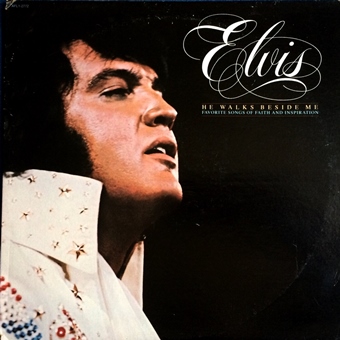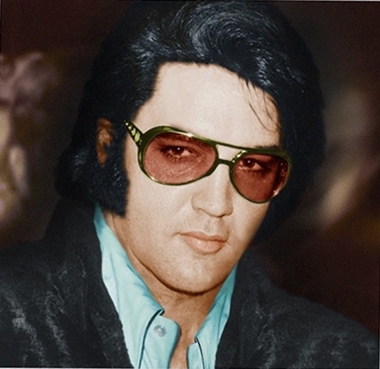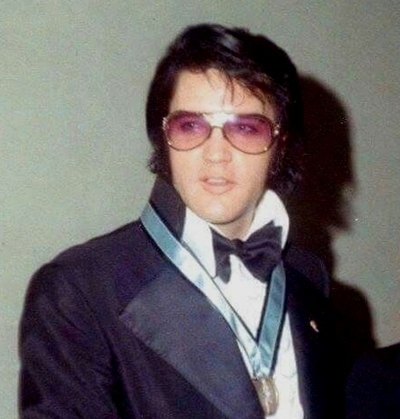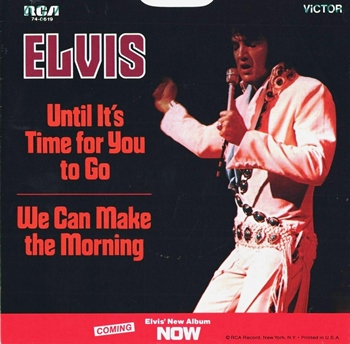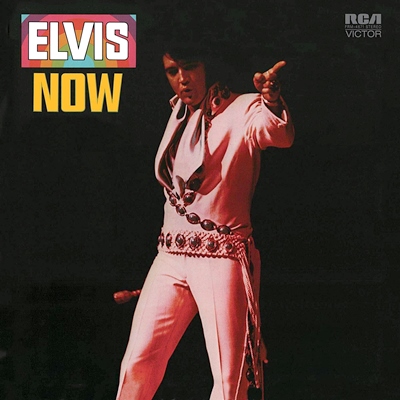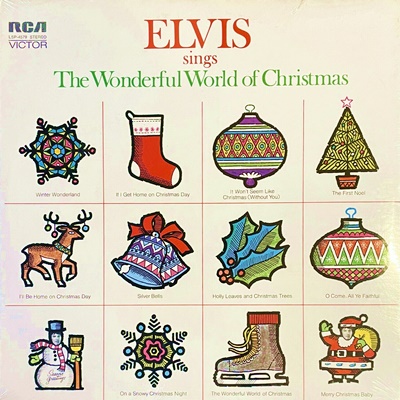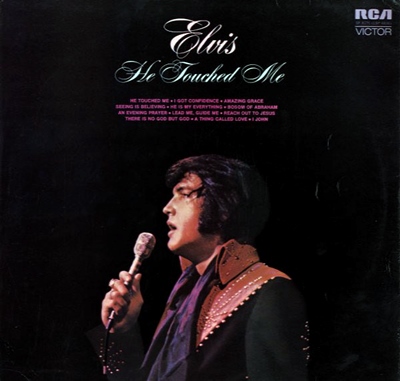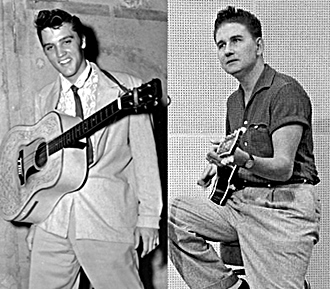 |
 |

Think Twice: Elvis in the Studio, 1971 This article came about following a trip to a record fair at the beginning of August. I was at a stall that had around a dozen boxes of LPs marked up at 3 for £10 (all of them unsorted – don’t get me started on what I think of that!). One of the albums I came across was He Walks Beside Me. A couple of years ago, I would have passed up on the chance of buying it, but middle-age seems to have made me rather sentimental about the records I used to have when I was young. I sold almost all of them when I went to university when I was thirty, and didn’t care too much about it at the time. But now I find myself buying them back for old-time’s-sake, even if I have the material elsewhere. And so I bought He Walks Beside Me and a couple of other albums, and came home. A week later, I was in a charity shop and saw a copy of Inspirations. This K-tel album was one of my earliest entrances to the world of Elvis. Mum had the Camden Christmas album and the Hits of the 70s release, and then came home with both Inspirations and the You’ll Never Walk Alone album one day when I was about six. And that was it. That was the complete Elvis collection in our house until I bought the Heartbreak Hotel Camden with some pocket money when I was about nine and on a family shopping trip to Asda. And yes, I’ve bought that one again, too.
What surprised me about Inspirations and He Walks Beside Me when I listened to them again was some of the track selections. Both had He Is My Everything and Padre. I single those out as both come in for quite a lot of flak on Facebook groups and forums – and it’s fair to say that He Is My Everything on He Walks Beside Me might be the dullest opening track on an Elvis album since Take Good Care of Her on Good Times. But it got me thinking. The two gospel albums I had just bought were released within a few of years of each other. If we think these songs are perhaps two of the worst during the 1971 studio sessions, why were they used twice in short succession on compilations? Were they thought of differently back then? What did we, a family of casual listeners to Elvis, think of them back in 1980? He Is My Everything is, as most readers will know, a reworking of There Goes My Everything, which may well account for its inclusion on these two posthumous compilations. There Goes My Everything had been a #6 hit in the UK for Elvis back in 1971, was included on the UK Hits of the 70s album, and heard regularly on the oldies radio stations when I was growing up. This may well have been at least part of the reason why the religious rewrite popped up on both of these compilations. On the other hand, it’s rather difficult to understand why Padre was included on either of these discs. After all, it’s not actually a gospel tune at all, but a rather melodramatic pop song which Elvis named as one of his favourite songs at a 1958 press conference, referring to the Toni Arden single of the same period. Elvis’s version is a rather strange concoction. The arrangement is different to Arden’s – beefier, faster, and more dramatic, while drawing somewhat on the song’s Mexican origins – the melody of the verse is based on La Paloma Azul, and I urge you to check out Dave Brubeck’s beautiful performance on the album Bravo! Brubeck! But Elvis’s vocal doesn’t actually stray all that much from Arden’s. The phrasing is often the same, and it may well be the attempt to marry Arden’s vocal phrasing with the very different musical arrangement that is the song’s downfall. Simply speeding up Arden’s phrasing just makes it sound all the more melodramatic and bombastic and the result is rather chaotic. Even so, it’s clear that Elvis still loved the song, and he clearly still loved Mario Lanza, too – his singing of the line “what happened to our love so true” is pure Lanza phrasing, especially the emphasis of the word “love.” The song has become something of a rather pathetic schoolboy-style running joke on forums and Facebook groups, but when heard outside of the other material from the same session, it isn’t all that bad. Sure, it’s over-the-top, in a not dissimilar way to the ballads from the September 1970 session, but is it really as bad as all that? Well, we have come to learn over the years that there is much hyperbole in the Elvis world, and many revel in it.
But let’s stop and rewind a little. It’s very easy to look at the March, May and June 1971 recordings out of context. While the recordings are certainly not up to the standard of those from June 1970, it’s also true to say that Elvis was in a very different place personally by spring 1971. In June 1970, he was riding the crest of a wave with regards to his popularity and recent successes both on record and on stage. However, in January 1971, he was in the newspapers and gossip columns due to an ongoing paternity suit. It was eventually dropped, but Elvis was rattled by it, even having referred to it in his November 1970 concerts. Also in January, there were reports of death threats against him, which were taken seriously enough to prompt one newspaper to report that “his opening on Tuesday night at a Las Vegas hotel will be amid some of the tightest security in the resort city’s history.” That Las Vegas season was marred by short shows, fooling around, and mediocre reviews. Meanwhile Presley’s marriage was on the rocks, and he was having problems with his eyes, resulting in him cutting the session short in March 1971 in order to check into a hospital for treatment. And so, it’s fair to say that the 1971 sessions didn’t arrive at the best time for Elvis. But, as Sony are releasing the (already expected) four-disc set of the studio material from this troubled year, it’s only apt to revisit them for a closer look. The new boxed set will be interesting because, finally, the masters will be stripped of their overdubs and put together in their various genres. That means that, for the first time, all of the country and folk recordings will be gathered together in a way that they should have been when first released. It seems remarkable that this hasn’t happened before, and the tracklisting certainly looks far more coherent than Elvis Now or Fool (and yes, before someone writes in, I know that Fool isn’t the real name of that LP, but it’s obvious why I have been using it here!). There has been discussion on forums and groups as to whether the set should even be released at retail level at all, but, despite the view of many fans on these performances, there is much to appeal to the non-fan, not least the amount of familiar material here, such as Amazing Grace, My Way, Fools Rush In, Help Me Make It Through the Night, and Lady Madonna, as well as the Christmas material, too. The non-fan won’t know about the problems that beset these sessions, and they won’t know in advance that some of the performances are lacking. In all likelihood, they won’t notice the vocal deficiencies when they listen to them either. As fans, we often dissect Elvis’s legacy rather than just putting a disc in the CD player and enjoying it. Casual buyers – and the Christmas-present-for-Aunty-Mabel buyers – are not likely to come away thinking “my, how his voice went downhill in a year.”
Returning to the sessions themselves, perhaps asking for a Christmas album, a gospel album, a regular album, and single sides from one long set of sessions was too much, and put undue pressure on Elvis to start with, especially when life was hardly going well. This would come to forty or so sides being recorded – and that wasn’t achieved even within the mammoth June 1970 sessions. True, there were times when he had recorded an album in one or two nights, but that was long in the past by 1971. As many are aware, Elvis’s plan for the regular album was based around a folk music theme. But this was certainly not intended to be a straightforward folk album, in the same way that the country album recorded the year before had not been straight-ahead country. This was the project that Elvis focussed on in the session on March 15 th. The First Time Ever I Saw Your Face was recorded here, and Elvis first tried it as a duet with Ginger Holladay and before aborting that and trying it as a solo. But the arrangement was too forceful, too heavy, to work on a tender, fragile song such as this. Despite this (and the fact it was released only as a B-side at the time), Elvis added the song to his concert repertoire, performing it only occasionally at first before including the song in all shows of the August/September 1973 Las Vegas season. But, as the first song of the session in March 1971, it was hardly a great start, despite the new direction. Elvis then turned to Amazing Grace, which could have been intended for either the folk or gospel album. Like First Time, the master is something of a directionless recording, with little to distinguish it – and yet a bluesy earlier take was discarded despite being far superior. The March session ended with a couple of Gordon Lightfoot songs, which saw Elvis taking a much more traditional foray into the folk sound and genre, and Early Morning Rain and For Lovin’ Me find him singing in a committed-and-yet-relaxed manner that we might associate more with his gospel singing – compare the vocal on these to the gospel jam recorded during the filming of Elvis on Tour the following year, for example. It perhaps hadn’t been a session of the highest quality, but by the end of the evening four usable cuts were on tape, and in all likelihood the folk album would have been finished and released as a whole if it wasn’t for the hospital trip. But when Elvis returned to the studio in May, he had lost his focus and, it seems, much of his enthusiasm for the folk album. Despite this, he still tackled some songs that, in all likelihood, had originally been pencilled in for that album.
There was the lovely, freewheeling jam of Don’t Think Twice, It’s Alright, that was hacked to less than three minutes when it was finally released in 1973. Elvis also recorded Until It’s Time For You to Go, Buffy Sainte-Marie’s beautiful composition that is simply not gentle enough in Elvis’s hands, although I confess that I have come to appreciate the recording a little more in recent years. And while many have said that Elvis just didn’t care much in the studio in 1971, he came back in June to try the same song again, which at least shows there was commitment to the songs that he cared about. There was a short informal recording of a verse or two of Dylan’s I Shall Be Released, although whether that was on the original agenda for the folk album is unknown. And, certainly, Elvis’s rather bizarre recording of A Thing Called Love (sung in unison with Armond Morales) could have fitted on to a folk-themed album without too much of a stretch of the imagination. There was also I’ll Take You Home Again, Kathleen, recorded on May 19th as one of a trio of songs that Elvis recorded alone at the piano. I’m not one to criticise Felton Jarvis a great deal. His job to get an increasingly-erratic artist to deliver during the seventies was one I don’t envy, but one has to wonder why he didn’t encourage Elvis to sing just one more folk number. After all, eight were already in the can, and a five or six-minute edit of Don’t Think Twice could have resulted in a nine-track album being satisfactory. The other possibility could have been to have used I Was Born about Ten Thousand Years Ago as the extra required track, thus linking the album with the previous country LP. Indeed, Don’t Think Twice would have been perfect to use to link the tracks on the folk album, just as the gospel number had been used on the country disc. For whatever reason, a folk album wasn’t patched together, and the above songs were spread out over two sub-par albums and several singles. The other country and pop recordings from the May and June sessions were a mix of the inspired and the insipid. Elvis tackles I’m Leavin’ with all of the care and delicacy that should have been given to Until It’s Time For You to Go and The First Time Ever I Saw Your Face. Fools Rush In and Help Me Make It Through the Night were bog-standard run-throughs of good songs that seemed to have been thought of as nothing more than album filler even when they were recorded. Ironically, Elvis had delivered a much better version of the former during his home recordings in the mid-1960s, singing to an album of karaoke-style backing tracks by Nelson Riddle. We Can Make the Morning was a decent enough song ruined by a lack of attention – the backing vocals are not together, and it gives the whole song a ragged feeling. But that was a masterpiece compared with Love Me, Love the Life I lead, which suffers from all the things that Padre is regularly accused of: a key that was too high, a bombastic vocal, and an arrangement that left much to be desired. It’s a pity, because it leaves us with the impression that this could have been a good recording on any other occasion. What happened after the session made things seem worse. It’s almost as if the names of these songs and the folk songs were put together in a bag, with a handful of the gospel tunes and leftovers from the previous sessions, and then pulled out randomly in order to put together the next two regular studio albums.
Certainly, it appears that more thought and attention was put into the tracklistings of the aforementioned He Walks Beside Me and Inspirations than Elvis Now and Fool. Elvis Now was a mess of an album, and Don Heckman of the New York Times commented on the “thick and overdone” production as well as Elvis’s wide vibrato – a problem that would often arise in the 1970s when Elvis was bored and/or tired. He also stated that “it sure would be good to hear this still-gifted pop performer recover some of the fire and passion that were once so much a part of his music.”
The Fool album was both better and worse than Elvis Now. They might have been low-key, but it’s a joy to hear the piano songs, For Lovin’ Me, the February 1972 recording of It’s Impossible, and the severely-truncated version of Don’t Think Twice, It’s Alright. But the care and attention given to them was countered by the overcooked Padre and the histrionic Love Me, Love the Life I Lead. It wasn’t an album that could ever have cashed in on the success of Aloha. Billboard merely stated that “Elvis sings softly and nicely and professionally,” which is hardly great praise. One has to wonder why Fool wasn’t shelved in favour of another volume in the Gold Records series, in order for Elvis to come up with a decent follow-up to the Aloha album. It’s certainly true that part of the reason why fans view the 1971 recordings in the way that they do is because of the way they were released. “George Smith” on FECC came up with Exodus a couple of years ago – an album-that-never-was which shows these recordings in a much better light.
Aside from the secular material, there were two more albums of material recorded in these sessions during May and June 1971. The Wonderful World of Christmas LP must have been titled by a comedian given that this is the most depressing Christmas album anyone is ever likely to hear. The title song is actually rather nice material in the style of If Every Day Was Like Christmas, as is On a Snowy Christmas Night. O Come All Ye Faithful is a beautiful and intricate version of the famous carol, and the likes of It Won’t Seem Like Christmas are decent enough. But alongside these are the miserable new songs: Holly Leaves and Christmas Trees, I’ll Be Home on Christmas Day, If I Get Home on Christmas Day. Even more depressing is a version of Winter Wonderland which is utterly joyless, and The First Noel, which, alongside Hey Jude and Never Again, could well be the worst non-soundtrack recording that Elvis ever made. Needless to say, the Christmas album is a bore and, while it sold well, it has never threatened to become a perennial favourite like the 1957 seasonal effort has. However, it’s worth wading through it just to hear Merry Christmas Baby , which is Elvis’s best blues recording, and was proof that he could still get caught up in the joy of music-making when the right song came along and he was in the right mood. Obviously, it was edited for release, but at least five minutes or so were retained for the album, and no-one thought of keeping the full seven minutes and ditching the awful The First Noel instead.
At least Elvis was considerably more invested in the gospel album. He Touched Me has a rather different feel to Elvis’s other gospel albums, with the rock aspects of I’ve Got Confidence and Seeing is Believing giving it a more contemporary feel. The latter is rather clumsy, I feel, and doesn’t quite work, and Elvis would probably not get to the heart of this type of gospel number until I Got a Feelin’ in My Body , recorded in December 1973 at Stax. Elsewhere, there are some very fine vocal performances on He Touched Me, An Evening Prayer and Reach Out to Jesus , as well as on the more traditional sounds of Bosom of Abraham and I John , even if they may well have been recorded just to fill the album out. On the other hand, a track like There is No God but God is banal and trite, and one has to wonder if this was really the best material that could be found. Still, the album won a Grammy. It’s worth adding here that some sources say that Miracle of the Rosary and Put Your Hand in the Hand were leftovers from the He Touched Me album and were slotted on to Elvis Now . However, Elvis Now was released a couple of months before He Touched Me . The forthcoming 4 CD set is going to shine the spotlight on these sessions, which have traditionally been ignored by the official label. Many will remember that it took FTD eight years to release a disc of outtakes from these recordings ( I Sing All Kinds ) – twice as long as it took the same label to issue material from Double Trouble and Harum Scarum . In fact, the May session in particular has almost been regarded as the black sheep of the post-comeback years, no doubt because there is a noticeable reduction in quality for much of the time when compared to the year before. It is certainly true to say that the advertising so far for the new set somewhat exaggerates the wonders of these performances. One refers to this being “some of the most compelling singing of [Elvis’s] career.” While such a claim is nonsense (unless they are referring to just two or three tracks), there was something interesting going on during these sessions, even if the results were not always particularly good. What is perhaps startling if we put our personal views aside is the ambition with which the 1971 studio sessions were approached. Firstly, Elvis was expected to record somewhere around thirty-five to forty songs, which is a remarkable number. Especially considering that the marathon session from the year before ran out of steam during the last day, and probably would have done so earlier had Elvis not gone down the route of a country album halfway through. Not only was he looking at the sheer number of songs to record, but also that two of the albums were to be themed – something which would prevent him from simply recording some old songs that he remembered from the past as he had done with the country album. And Elvis made the sessions more ambitious by going in with the idea of the third album being themed also. That didn’t work out in the end, but the ambition was still there at the outset. The pre-set agenda gave Elvis little flexibility. Even at American Studios in 1969, Elvis was able to reach back into the past and launch into the likes of After Loving You and I’ll Hold You In My Heart . He was able to do the same at Nashville in 1970 (various country songs), at Stax in 1973 ( Spanish Eyes , She Wears My Ring ), in Hollywood in 1975 ( Shake a Hand ), and in the Jungle Rooms in 1976 (Danny Boy, Pledging My Love ). In the 1971 and 1972 studio sessions, that was more difficult. The only chance that Elvis got in 1971 was when he recorded the three piano songs. For the rest of the session, there was little hope of the agenda being set aside long enough for Elvis to launch into an old favourite. Within that three-themed-album challenge that Elvis had set for himself, there were yet more challenges. Instead of just drawing on a bunch of old warhorses when it came to the Christmas album, Elvis turned to a bunch of brand-new songs for roughly half of the disc. Yes, he churned out tired versions of Winter Wonderland and Silver Bells , but he could have done that for the rest of the album. No doubt it would have been easier for him to sing Have Yourself a Merry Little Christmas, The Little Drummer Boy and The Christmas Song than to learn a bunch of new, and sometimes quite difficult, songs. And he tried hard enough to go back and remake one of them in the June sessions. The same was true of the gospel album. There must have been a temptation to return to the formula of His Hand in Mine or How Great Thou Art, and simply resurrect songs from the past. Again, though, instead he tried to make the album more contemporary and more varied than either of the two gospel albums. Instead of staying in one or two styles, he moves from the Christian rock through to old spirituals and gospel songs, hymns and religious songs from the 1940s and 1950s, as well as the almost operatic An Evening Prayer. Moreover, there were challenges within individual tracks as well. The first song of the March session was due to be a duet of The First Time Ever I Saw Her Face. That didn’t work out in the end, but Elvis attempted it, nonetheless, despite never having approached a song in this way outside of soundtrack sessions. There were also the three piano songs which Elvis recorded in the May session. There is nothing else like them when it comes to studio sessions in Elvis’s career. Sure, we have similar performances in the home recordings that have emerged since the 1980s, but, again, this was Elvis going into the studio and wanting to try something different.
And how about the unique arrangement of A Thing Called Love? It doesn’t really work, but there’s nothing quite like it (for better or worse) elsewhere in the Elvis catalogue. There’s also nothing else quite like I’m Leavin’. A song that’s extremely difficult to sing, and with its roots firmly in pop rather than rhythm ‘n’ blues or country, a rather alien milieu for Elvis to work in. And yet Elvis was keen to work at it (and the other pop tune, It’s Only Love, although this is less successful). Then, there’s the attempt at a very different arrangement of My Way in the June session. The dark, ominous piano that underpins the arrangement, and Elvis’s largely understated and morose reading of the song, shows that he was attempting something unusual with the material, quite unlike Sinatra’s single and almost every cover version that had appeared in the year or two after its release. Again, it didn’t work, and Elvis later approached the song in concert in a more traditional way, but that seems almost beside the point. Elvis was experimenting. And what was Elvis trying to get at with his two extended jams of Don’t Think Twice, It’s Alright? Both of them run well over ten minutes. There’s no other recordings of Elvis jamming a song for that length of time or with that much involvement. Despite not knowing half the lyrics, he goes over and over the material. With the repeat of each verse, he phrases it differently, just as a jazz singer phrases a song slightly differently each time they sing it. He’s fully immersed in the music-making here, apparently reaching for something within the song itself – some nuance, some meaning, some phrasing – and by the end he still doesn’t appear to have found it. But his determination brought him back to try again. The twenty-five minutes of that Dylan song is almost like compressing twenty takes into one seamless whole, with the phrasing and approach changing with each verse/take. Let’s not forget the remarkable arrangement of O Come All Ye Faithful. As with a handful of the other recordings, it’s quite unlike anything else in the Elvis legacy, with the sombre close-harmonies of the first verse opening out in the joyous second verse and leading to a glorious finale which is truly magical. In the opposite direction was the bluesy take of Amazing Grace that first appeared in 1995. We’ll never know why that approach was ditched in favour of something more mundane, but Elvis was still attempting something new with the song when he first began work on it. It is very easy to look at these sessions with a glass-half-full approach. They’re not as good as the previous year. Elvis clearly wasn’t in the right headspace to be taking on a marathon session in May or June. For much of the time, he’s not in great voice either, with a rather disconcerting vibrato emerging when he got bored or tired – and he appears to have been bored for a substantial portion of these recordings. And yet, regardless of all these things, much of the session was given over to a search for something new. Something different to what the world had heard Elvis do before. And, while many of the things attempted didn’t come off (or got aborted before they could come together), looking back that almost seems irrelevant, because there is something strangely compelling in these sessions. It’s not his singing that’s compelling, as the blurb for the new boxed set might lead us to believe, but his ambitious and inquisitive approach to these sessions as a whole – and to certain individual songs. Despite Elvis not firing on all cylinders and clearly not being in a good headspace (or in the greatest voice), it’s his musical mind, his approach, and his tendency for experimentation here that makes these sessions fascinating. But here’s the admission: it took me forty-seven years and a casual purchase at a record fair to make me realise it.
Spotlight by Shane Brown. Click here to comment on this article - and have YOUR SAY Shane Brown is the author of Reconsider Baby: Elvis Presley, A Listener’s Guide, and has recently published the extended and revised 2nd edition of Bobby Darin: Directions. A Listener’s Guide.
EIN Website content © Copyright the Elvis Information Network.
Elvis Presley, Elvis and Graceland are trademarks of Elvis Presley Enterprises. The Elvis Information Network has been running since 1986 and is an EPE officially recognised Elvis fan club.
|
|


